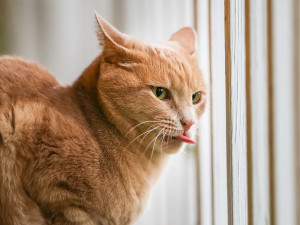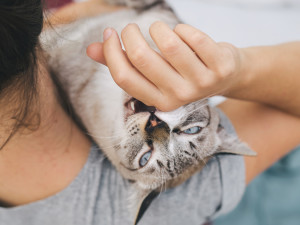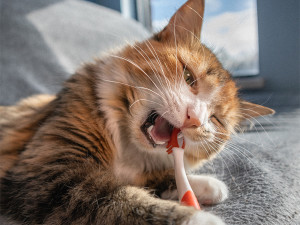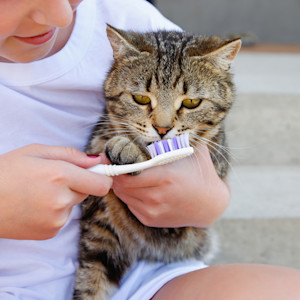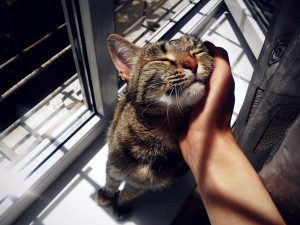
Share Article
In This Article:
Why Do Cats Drool? Why Is My Cat Drooling When I Pet Them? When to Contact a Vet When Drooling Frequently Asked Questions
Some of us wear it as a badge of honor, some of us would rather it weren’t a thing. Whichever category you fall into as a cat parent, most of us wonder: Why do some cats drool when you pet them?
Most of the time, drooling when being petted is a natural, normal thing that shows a cat is content and relaxed. But other times, drooling can be related to other issues that aren’t so normal. So, which is it? Read on to help determine why your cat drools when you pet them.
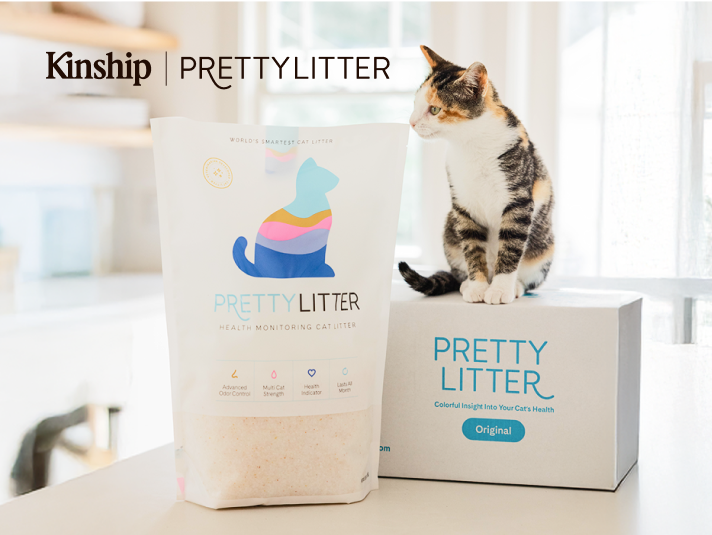
Save on the litter with color-changing tech that helps you better care for your cat.
Why do cats drool at all?
Saliva has many important functions. It lubricates food while you chew and swallow, it helps keep the mouth moist, and it helps to neutralize harmful microbes and acids. It is normally contained by the cheeks and lips.
How much do you spend on your pet per year?

Drooling in cats is simply when saliva escapes the mouth. Drooling occurs when either a cat’s body overproduces saliva or when their mouth can’t contain it all, allowing it to drip out. Why would either of these things happen?
Why is my cat drooling when I pet them?
We often don’t notice our cats drooling until it becomes excessive or when it’s dripping on our lap. Causes of that drooling may include:
1. Relaxation or happiness
One of the most common times you’ll experience a little cat drool is when you’re petting them. When a cat reaches their happy place, that place of pure contentment, they may drool because their jaw and lips relax, releasing saliva most likely onto your lap. This can also happen while sleeping.
2. Fear or anxiety
On the flip side, drooling can also happen when a cat is feeling anxious or fearful. Both of these emotions cause an increase in stress hormones, which can up saliva production as the body’s way of preparing for something. You may notice drooling when you take your anxious kitty on a car ride or when an unwanted dog ventures into your yard.
Cats that are overly anxious or fearful may be helped through behavioral modification and training or sometimes with medication.
3. Dental disease
Dental issues are one of the most common problems seen by veterinarians. Dental disease is so prevalent that over 80 perncet of cats over three to four years of age likely have some form of it. The buildup of plaque and tartar in a cat’s mouth can create irritation and inflammation that may increase drooling. It can be very painful and even lead to tooth loss and infections.
Dental disease is best treated and prevented with a veterinarian’s help. Regular professional cleanings and at-home brushing can keep a lot of issues at bay.
4. Respiratory issues
Coughing, sneezing, and watery eyes all play a part in feline respiratory issues. Drooling can also be a part of it as some viral causes of respiratory issues, especially calicivirusopens in new tab, can also lead to sores and irritation in the mouth. Similar to dental disease, drooling may be seen due to increased production of saliva to buffer this irritation.
Respiratory issues may resolve on their own within a few weeks if mild, while more severe causes may require veterinary intervention.
5. Nausea
Who hasn’t gotten a little carsick on a windy road or smelled a smell so terrible it made you a little queasy. A part of feeling nauseous is often drooling as the body’s way of increasing the saliva buffer to protect the mouth should the nausea lead to vomiting.
Kitties can become nauseated on car rides or from any number of stomach issues. Desensitizing your cat to traveling by going for short car rides and gradually increasing the distance can help. So can getting to the bottom of your cat’s stomach issues.
6. Catnip
Catnip contains the chemical nepetalactoneopens in new tab, which has a stimulating effect on about half the cats who come in contact with it. Along with causing rolling, rubbing, and a serious case of the zoomies, it can also increase salivation which can turn into drooling. Catnip usually wears off after about 10-15 minutes, so if your cat’s catnip drooling is out of control, rest assured it shouldn’t last long.
7. Toxins or poisons
Your cat’s environment is filled with potential toxins or poisons. Not to raise the alarm here (most of the time our cats don’t ingest them), but things like household cleaners, certain plants, and gardening products can be dangerous to your cat if eaten. Most of the time, toxins are irritating to the mouth and throat, causing drooling, pawing at their mouth, vomiting, or other signs.
If you suspect your cat ate a toxin or poison, consult a veterinarian or the pet-poison helplineopens in new tab immediately for the best course of action.
8. Medications
Cats aren’t known to be willing takers of medications, but let’s be honest: no animal really is. That’s because some medications can have a bitter or unpleasant taste that can cause drooling. Some medications can also make a cat nauseous, also potentially leading to drooling.
If your cat recently started a new medication and has started drooling as a result, contact your veterinarian to make sure this is a known side effect and for tips on how to help them.
9. Heatstroke
Cats don’t have a very efficient cooling system. Rather than being able to sweat, they instead have to rely on panting or seeking shade to keep their body temperatures in check. When this fails, they can overheat, a potentially serious condition known as heatstroke. Cats with heatstroke often appear restless, will be panting, uncoordinated, or vomiting. They may also drool as their body tries to increase their cooling capabilities.
Heatstroke is an emergency, so get your kitty to a vet as soon as possible. You can start the cooling process by wetting their hair with cool, not cold, water or placing cool towels on their groin and belly.
10. Other Health Issues
Foreign objects, such as string or rubber bands, can get stuck in a cat’s teeth, potentially causing drooling. Your kitty may also paw at their mouth or not want to eat if this is a problem. You can try removing foreign objects if you can do so safely, otherwise see your veterinarian.
Some neurological issues, as well as kidney and liver diseaseopens in new tab, can cause a cat to drool either due to nausea or inability to control their muscles normally. It’s best to have any abnormal drooling checked out by a vet.
When to contact a vet for drooling
A happy, purring cat that drools is no cause for concern. They’re just letting the pleasures of life get the best of them and have ventured into their relaxed and content space. This is also true if you’ve just given them a helping of catnip.
Drooling during any other time may be a cause for concern. If your kitty is drooling, along with showing other signs like not eating, lethargy, bad breath, excessive panting, or difficulty breathing, it’s time to see a vet.
Even drooling during car rides may need medical attention, especially if you plan to travel with your cat.
Bottom line
Drooling while you pet them is a natural behavior for most cats. It means they are happy and relaxed and simply letting a little saliva slip from their lips.
Drooling during other times may mean that something is up and often deserves a visit to the vet. Things like dental disease, nausea, and respiratory issues may all be to blame.
See your vet if your cat has just started drooling or if they are showing any other signs.
FAQs
Why does my cat drool when affectionate?
When cats are relaxed and content, they may drool simply because they have let their guard down and have relaxed their jaw and lips, allowing drool to come out. They may also drool when sleeping for the same reasons.
Do cats drool when they’re happy?
Drooling can be a sign that your cat has reached a state of pure relaxation and happiness. They are peaceful and calm, allowing the muscles in their jaw and lips to relax and drool to escape.
Is it normal for a cat to drool while purring?
Drooling while purring or while you pet them is the ultimate sign that a cat is content and happy. They are happy enough to let their jaw and lips relax, allowing saliva to drool out.
References
“Feline Calicivirus.” Baker Institute for Animal Health. Cornell University College of Veterinary Medicine. https://www.vet.cornell.edu/departments-centers-and-institutes/baker-institute/research-baker-institute/feline-calicivirusopens in new tab.
“Heatstroke in Cats—Symptoms and What You Should Do.” animERge. https://www.animergevets.com/site/blog/2021/02/15/heatstroke-in-catsopens in new tab.
“Meet the Molecules—Catnip.” John Innes Centre. 14 Nov 2018. https://www.jic.ac.uk/blog/meet-the-molecules-catnip/opens in new tab.
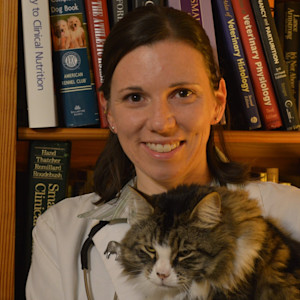
Dr. Chyrle Bonk, DVM
Dr. Chyrle Bonk has been a mixed-animal veterinarian since 2010, with a special interest in rehabilitation. When she's not practicing or writing about veterinary medicine, you may find her exploring the outdoors with her family or tending to her cows, horses, chickens, or cats and dogs.
Related articles
![Cat with a toothbrush]()
7 Cat Dental Products You Never Knew You Needed
Vets explain how fish-flavored toothpastes and nifty finger brushes can prevent more than “tooth fur.”
![Woman brushing cat's teeth.]()
Taking Care Of Your Cat’s Teeth Might Just Help Them Live Longer
Health issues that begin in the mouth do not stay in the mouth. Stop them before they start.
![Cat being happily pet in the sunshine of a window]()
How to Pet a Cat (Without a Scratch)
There is a right and wrong way.
Do Cats Like to Be Touched? These Are the Places They Prefer to Be Pet
And the surprising way to get your kitty to be more affectionate.
